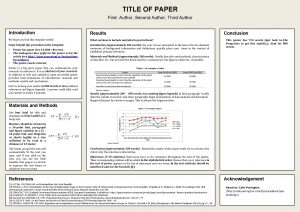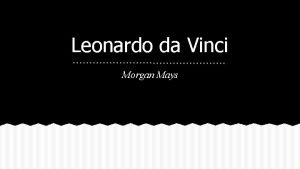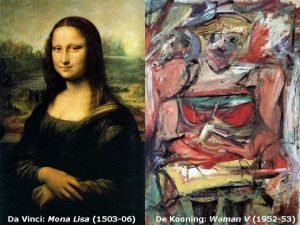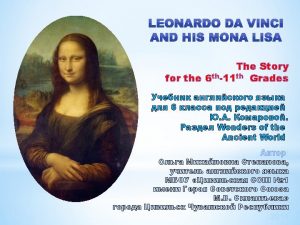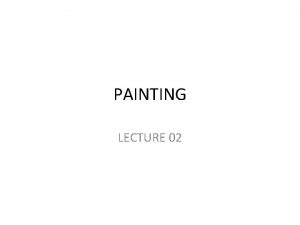Mona Lisa Secret painting Author of the painting







- Slides: 7

Mona Lisa Secret painting

Author of the painting -… …Leonardo da Vinci Leonardo di ser Piero da Vinci was an Italian Renaissance polymath: painter, sculptor, architect, musician, mathematician, engineer, inventor, anatomist, geologist, cartographer, botanist, and writer. His genius, perhaps more than that of any other figure, epitomized the Renaissance humanist ideal.

Description of the painting The painting, thought to be a portrait of Lisa Gherardini, the wife of Francesco del Giocondo, is in oil on a poplar panel, and is believed to have been painted between 1503 and 1506. It was acquired by King Francis I of France and is now the property of the French Republic, on permanent display at the Musée du Louvre in Paris. The ambiguity of the subject's expression, frequently described as enigmatic, the monumentality of the composition, the subtle modeling of forms and the atmospheric illusionism were novel qualities that have contributed to the continuing fascination and study of the work.

Secret of eyes Researcher Silvano Vinceti, chairman of the Italian national committee for cultural heritage, says he's discerned the letters "LV" — "obviously Leonardo's initials" — on the Mona Lisa's right pupil. "Far more interesting, " Vinceti says, are markings — which he's interpreted as the letters "B" and S, " or possibly the initials "CE" — that he found in her other eye. "Leonardo was keen on symbols and codes to get messages across, and he wanted us to know the identity of the model using the eyes, which he believed were the door to the soul and a means for communication, " says Vinceti. He also found the number "149" (with a fourth digit apparently having been erased) on the back of the painting. In a "Dan Brown–style plot device, " one of Vinceti's colleagues found an old book in an antique shop that referred to symbols in the painting's eyes, triggering new scrutiny. Eyes Mona Lisa are looking everywhere. No matter where you will stand up eyes Mona Lisa are looking at you…

Secret of smile When discussing the mystery behind the smile, art experts often refer to a painting technique called sfumato, which was developed by Da Vinci. In Italian sfumato means "vanished" or "smoky, " implying that the portrait is ambiguous and blurry, leaving its interpretation to the viewer's imagination. This technique uses a subtle blend of tones and colors to produce the illusion of form, depth and volume. The human eye consists of two regions: the fovea, or central area, and the surrounding peripheral area. The fovea recognizes details and colors and reads fine print, and the peripheral area identifies motion, shadows and black and white. When a person looks at the painting, the fovea focuses on her eyes, leaving the peripheral area on her mouth. Peripheral vision is less accurate and does not pick up details, so the shadows in her cheekbones augment the curvature of her smile. When the viewer looks directly at the woman's mouth, however, the fovea does not pick up the shadows, and the portrait no longer appears to be smiling. Therefore, the appearance and disappearance of her smile really is an attribute of viewers' vision. This is one of the reasons why the

Copy of a painting The earliest copy of Leonardo da Vinci's masterpiece, Mona Lisa, has been found in the vaults of a Spanish museum, looking younger and more ravishing than the original. Art historians have hailed the discovery, made during conservation work at the Prado Museum, as one of the most remarkable in recent times. Museum officials said it was almost certainly painted by one of Leonardo da Vinci's apprentices alongside the master himself as he did the original.

Thank for watching my presentation. Patrycja Orman

